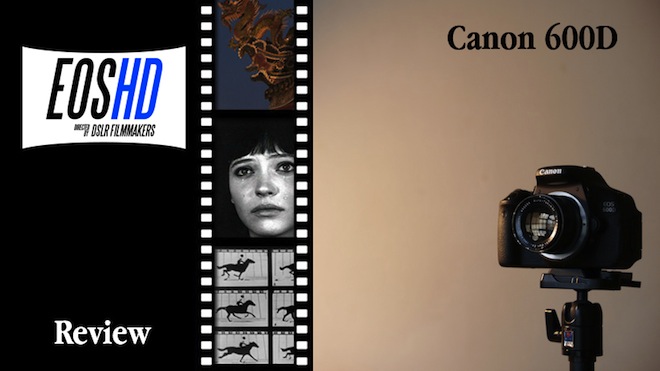
The Canon 600D review – or should I say, the Canon 60D review revisited. There is no denying that the 600D is a very similar camera but that it also brings some new features not seen in the 550D or 60D, especially for video.
Of all the Canon video DSLRs, the 600D is definitely the best value for money at the moment. The rotating screen makes it a worthy upgrade over the 550D. As we know, the 7D is more expensive because of it’s better build, prized auto-focus system and better HDMI output as well as faster burst shooting. The 5D Mk II is of course more again because of it’s unique full frame sensor. It is no wonder we have had so long to wait for proper successors to these cameras, since they don’t really have much competition except from Panasonic. It took Nikon a year to make a camera as good as the 7D, the D7000 and it’s video mode has a major issue with live view exposure simulation. The jury is out on the D5100 but even if that is fixed it isn’t any better than the 600D for image quality. The very fact that these Canon DSLRs are often compared to the likes of RED and Sony F3s shows how insanely good the end result can be if you don’t pixel peep too hard. A video mode which was meant for photographers to record snapshot videos for uploading online, has gone onto shoot Hollywood pictures and major TV network shows, on a camera which costs $900.

Above: Get your screens out. 600D’s is better.
It would seem impishly naive and petty to pick holes in the 600D after looking at the big picture, then – but another remarkable thing is that the Panasonic GH2 is a left-field wildcard on the market, able to completely outgun the 600D in some respects related to video because of it’s unique design as a ‘hybrid’.
I also feel the GH2 has better dynamic range in video mode as well as of course more detail. In stills mode the 600D has the edge especially at higher ISOs. But it loses a lot of the advantages of a better sensor, because it’s video image processing is so primitive.
The mirrorless lens mount, video optimised lenses, built in EVF, more compact body and lenses, and a more feature packed firmware give the GH2 a compelling reason why the 600D is starting to look old hat. It isn’t – it’s just that the GH2 is more forward facing when it comes to video. Stills, less so.
In my original review of the 60D vs GH2 that ended in a walkover for the GH2 both on features and image quality in video mode. The 60D offered nothing new over the 7D or 550D in video mode apart from a hinge, yet the GH2 solved all of the GH1’s image quality issues, became a competitor even at ISO 3200, and resolves more detail in 720p than the Canon does in 1080p!
In terms of functionality in video mode, the 600D is still a bit uninspired but it at least adds one GH2 video feature – a full HD crop mode. Detail is not bad – but not as good as the GH2. Otherwise it is okay – perfectly usable and unlike the GH2’s crop mode the HDMI output remains working so you can do monitoring whilst recording in crop mode. The GH2 crop mode’s raison d’etre for filmmakers however is so much a digital telephoto but the ability to crop into the image circle of 16mm cine lenses and c-mount offerings. You can’t mount the lenses on a Canon, so the feature is a bit more redundant.

GH2: More detail

600D: Less detail, and a bit less dynamic range (leaf highlights are blown)
Image quality wise sadly none of the issues of the prehistoric DIGIC-4 powered video mode have been addressed by the 600D, perhaps understandably. It still has a soft (though some would say cinematic) image that is much less a problem in reality than it appears when pixel peeped from a still frame side by side with the GH2 on a laptop screen – the worst possible way to view video imaginable.
More of a concern is that it still has moire, aliasing, poor 720/60p and 8bit colour compression causing banding on blue skies and subtle gradated tones. Canon is asking us to wait effectively 3 years from the 5D Mark II’s introduction of DiGiC 4 to get a fix for this, which I don’t think is fair. There is no reason why the 7D couldn’t have fixed it, with the better dual-core DIGIC-4 implementation.
The 600D gets a swivel screen, which was my main reason for choosing it over the cheaper 550D – otherwise, the image is the same as the 550D since it shares the same hardware. The improvements to the 600D are purely firmware and body related, of which the screen, crop mode and auto-picture profile selection are the most significant.
I think the 600D feels better in the hand than the 60D. I am not a fan of the locking mode dial on the 60D, I find it uncomfortable to hold the lock button down and turn the wheel. That’s a small thing but on a part of the camera that you use very often so it annoys. Also the 600D is smaller than the 60D but feels just as well built – much higher grade plastic is used than in the GH2 and it feels much more solid. I strongly recommend getting hold of a ReWo GH2 cage if you are a GH2 user – the body is just not made to last like a 5D Mk II or 7D. The 600D sits nicely in-between – it’s only plastic – but fibre reinforced and high grade. Good move Canon.
The screen and focus assist are of higher quality than the GH2 and there isn’t the annoying gamma shift between live view and recording that the GH2 has. Unfortunately you cannot half press the shutter release to get out of focus assist, instead it requires two button presses and only one button on the camera provides the function, and it’s not exactly in the most ergonomic place. HDMI for monitoring is the same as the 550D, 60D and 5DMkII – meaning that it’s essentially crap! Huge blank out times when recording starts and a big loss of HD resolution, though in all practicality if you have good scaling in your EVF or monitor (like the latest Zacuto EVF or the SmallHD DP6 do) it is not that noticeable and doesn’t hurt practicality.
The scroll wheel on the back is gone compared to the 60D and the viewfinder is very small. These are areas of line-differentation rather than purely cost elimination, since 1970’s SLRs have larger viewfinders and $99 compact cameras have scroll wheels. Of course they can have a bigger viewfinder and a scroll wheel at the 600D’s price point but they won’t because they need to save these features for higher end models to make cameras like the 5D Mark II a more attractive upgrade.
But then Canon are being generous enough to give us this much image quality and the same sensor as the 7D for almost half the price – so I’ll let that go.
Instead of the scroll wheel then, we have a Nintendo d-pad from 1982. However the camera feels so well laid out and comfortable that I don’t really miss the rotating scroll wheel of the 60D. It doesn’t feel as solid but it gets the job done just as quickly. Also good to see a dedicated ISO button and WB button. I feel that the buttons which have moved compared to the 60D have moved for the better. It really does feel good to use.

Above: 600D battery is small and annoying, like Richard Hammond.
The battery has reduced in size, just like the GH2’s did over the GH1. Why this is happening I am not sure, since the physical size of the camera base stays the same. The battery in the GH2 is quite heavily compromised because of this and so is the 600D’s. In live view you get barely 2 hours use. Also Panasonic don’t even have a battery grip out for the GH2 yet, despite aiming it partly at semi-pros and videographers who shoot events. And they wonder why they lose sales!
So with the video image unchanged from the 7D, 550D and 60D, you may think the 600D is not such a big deal. I disagree – time has come to suggest that the Canon DSLRs may have one major important plus point over the all singing all dancing Panasonic GH2.
First, the 600D and 60D are the cameras I pick up when I take stills. In stills mode the 600D is clearly better than the GH2 – great JPEGs, punchy colour and contrast, very fine grain noise, optical viewfinder (if small and not very feature packed!), much better ISO 6400 performance which maintains a great deal of colour information as well as the finer noise grain to the image. What lets the GH2 down is the colour balance and JPEG output – it is a bit muddy and yellow, though both cameras are prone to pick up the greenish-yellow cast of energy saving lights – the major source of people’s frustration with the GH2’s colour on forums, I believe. You can counteract it with picture profile settings, but in low contrast scenes the GH2’s colour still looks a bit muddy compared to the Canon 600D.
More cinematic?
Perversely the softness of the 600D’s image creates less aliasing when the video is scaled on sites like Vimeo to 720p. The GH2 loses the silky smooth image of the 600D in these situations and looks electronic. The GH2’s footage needs a good display to back it up, or a projector. The extra detail actually looks distracting on a laptop screen. So in the way most people commonly view videos online, the 600D is going to look more organic and smooth. On the big screen, the GH2 will look like proper HD and the 600D looks good but a bit soft.
The 600D has a larger sensor, so it’s closer to the full frame look. It is a noticeable difference from the GH2, not massive but not small either. At F2 with an inexpensive lens you will get a shallower DOF on the 600D. On the GH2 it will still be pleasing but not as shallow – bokeh appears smaller, backgrounds less blurred. The GH2 benefits hugely from very fast optics – but these come at a price, like the Nokton 25mm F0.95. Also the gradated tones are slightly smoother on the 600D with less banding, especially around light sources.
Auto white balance has a more pleasing tone, and new to the 600D is an automatic scene-selection mode which chooses the right picture profile for the scene you are shooting, automatically. The GH2 only has this in iAuto mode but in that mode you have no manual control over video or 24p like you do in Creative Movie mode. Canon have balanced very well their new auto-features with manual control when required, but still lag behind on auto-focus – which doesn’t bother filmmakers, but will annoy camcorder point and shoot users.
Lastly the 600D has a higher bitrate implementation of H.264, which though much less efficient than the GH2’s more advanced AVCHD H.264 codec with b-frames, does not have as much compression going on.
The 600D is slightly brighter at the same ISO as the GH2. Since Panasonic realised their mistake with correctly calibrating the GH1, they changed tack on the GH2 but now it underexposes even the Canon at the same ISO! Good for reviews saying that ISO 1600 has less noise than the GH1 but not so good in reality.
Whilst I still prefer the GH2 overall, the 600D is undeniably a fantastic camera. I just feel Canon should be doing better at the moment and pushing forwards faster. The 600D is a victim of the Rebel line’s success and the strong sales stop Canon putting out something truly revolutionary. Stop buying these excellent cameras!
I have shot some comparison / example footage with the GH2 and 600D in Berlin side by side and it gives you an excellent idea of their relative strengths and weaknesses. Stay tuned to EOSHD later in the week for it’s reveal.


